Leadership: Comparing Japanese and Indian Cultural Dimensions
VerifiedAdded on 2023/01/19
|10
|1311
|40
Report
AI Summary
This report provides a comparative analysis of Japanese and Indian cultures, focusing on various cultural dimensions and their implications for leadership and business practices. The report begins with an introduction to the concept of culture, emphasizing its importance in communication and global awareness. It then delves into specific cultural dimensions, including uncertainty avoidance, power distance, individualism vs. collectivism, masculinity vs. femininity, long-term orientation, and indulgence vs. restraint, comparing the characteristics of Japan and India in each dimension. The analysis highlights both similarities and differences between the two cultures, providing insights into how these cultural nuances influence business etiquette, social customs, and overall societal behavior. The report also includes a section on business relations, discussing key aspects of business etiquette in both Japan and India. The study concludes with a list of references used in the research. This report is designed to enhance the reader's understanding of cultural environments, promote investigative research skills, and improve communication skills in a global context.
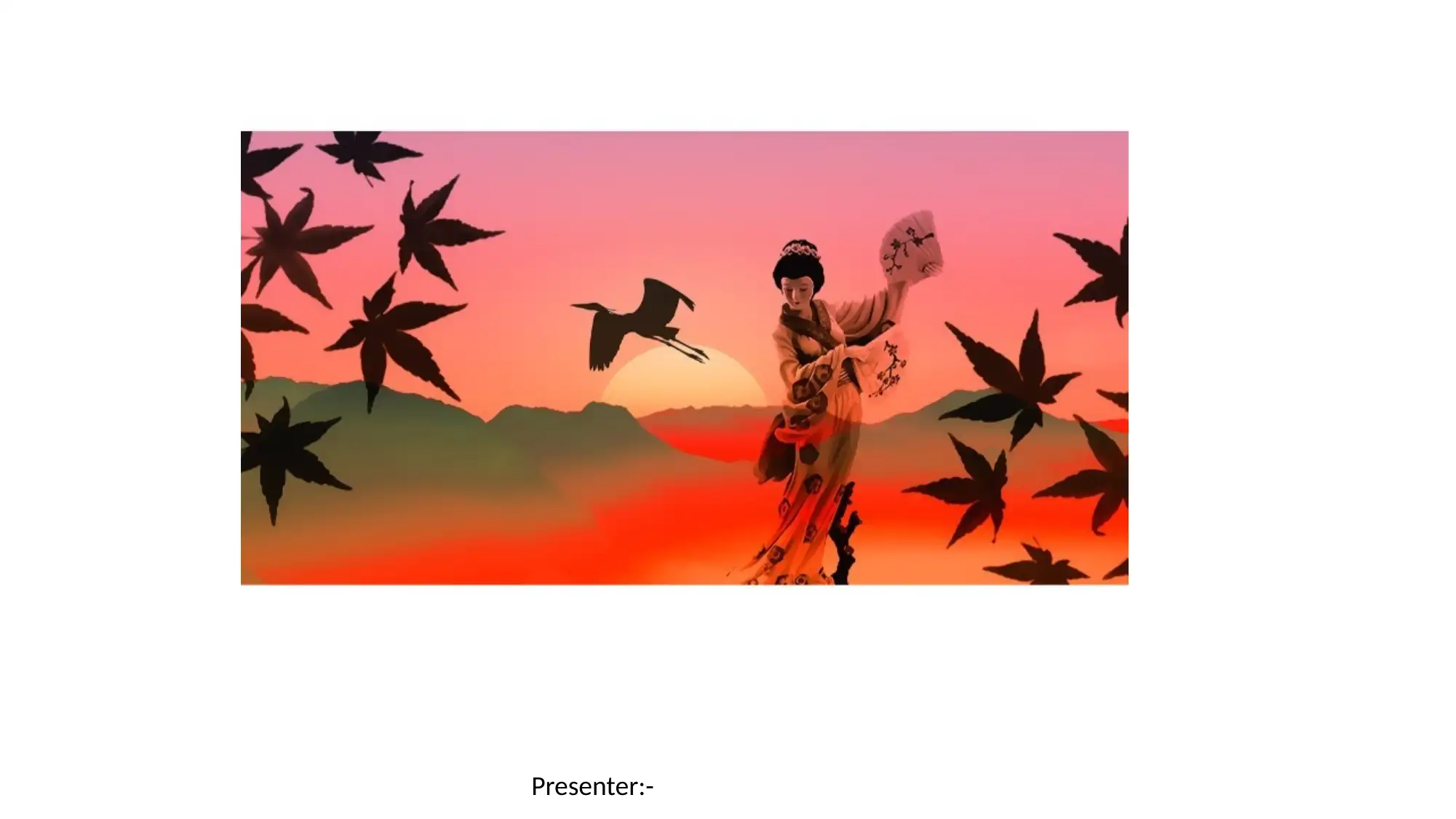
Presenter:-
Paraphrase This Document
Need a fresh take? Get an instant paraphrase of this document with our AI Paraphraser
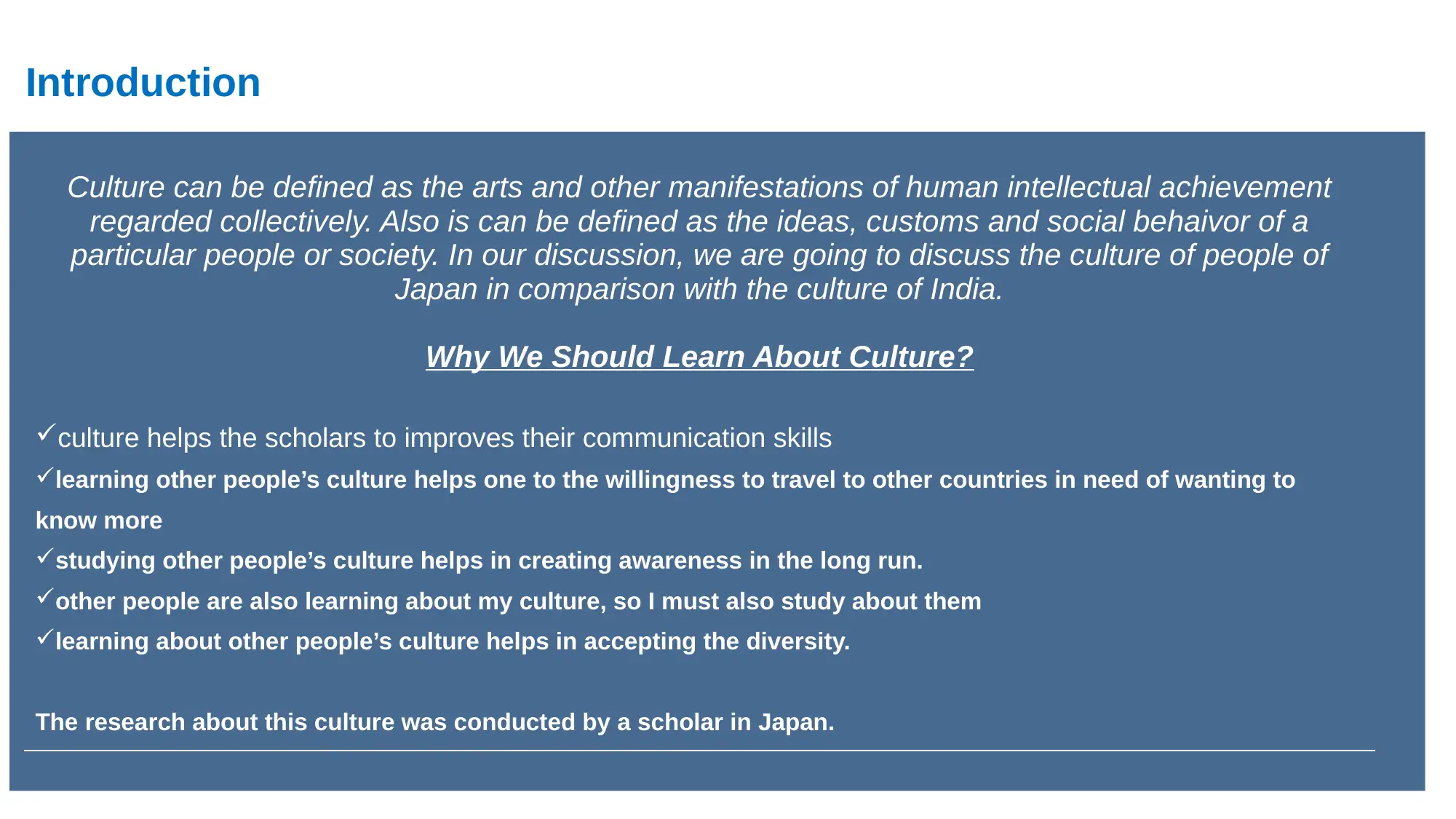
Introduction
Culture can be defined as the arts and other manifestations of human intellectual achievement
regarded collectively. Also is can be defined as the ideas, customs and social behaivor of a
particular people or society. In our discussion, we are going to discuss the culture of people of
Japan in comparison with the culture of India.
Why We Should Learn About Culture?
culture helps the scholars to improves their communication skills
learning other people’s culture helps one to the willingness to travel to other countries in need of wanting to
know more
studying other people’s culture helps in creating awareness in the long run.
other people are also learning about my culture, so I must also study about them
learning about other people’s culture helps in accepting the diversity.
The research about this culture was conducted by a scholar in Japan.
Culture can be defined as the arts and other manifestations of human intellectual achievement
regarded collectively. Also is can be defined as the ideas, customs and social behaivor of a
particular people or society. In our discussion, we are going to discuss the culture of people of
Japan in comparison with the culture of India.
Why We Should Learn About Culture?
culture helps the scholars to improves their communication skills
learning other people’s culture helps one to the willingness to travel to other countries in need of wanting to
know more
studying other people’s culture helps in creating awareness in the long run.
other people are also learning about my culture, so I must also study about them
learning about other people’s culture helps in accepting the diversity.
The research about this culture was conducted by a scholar in Japan.
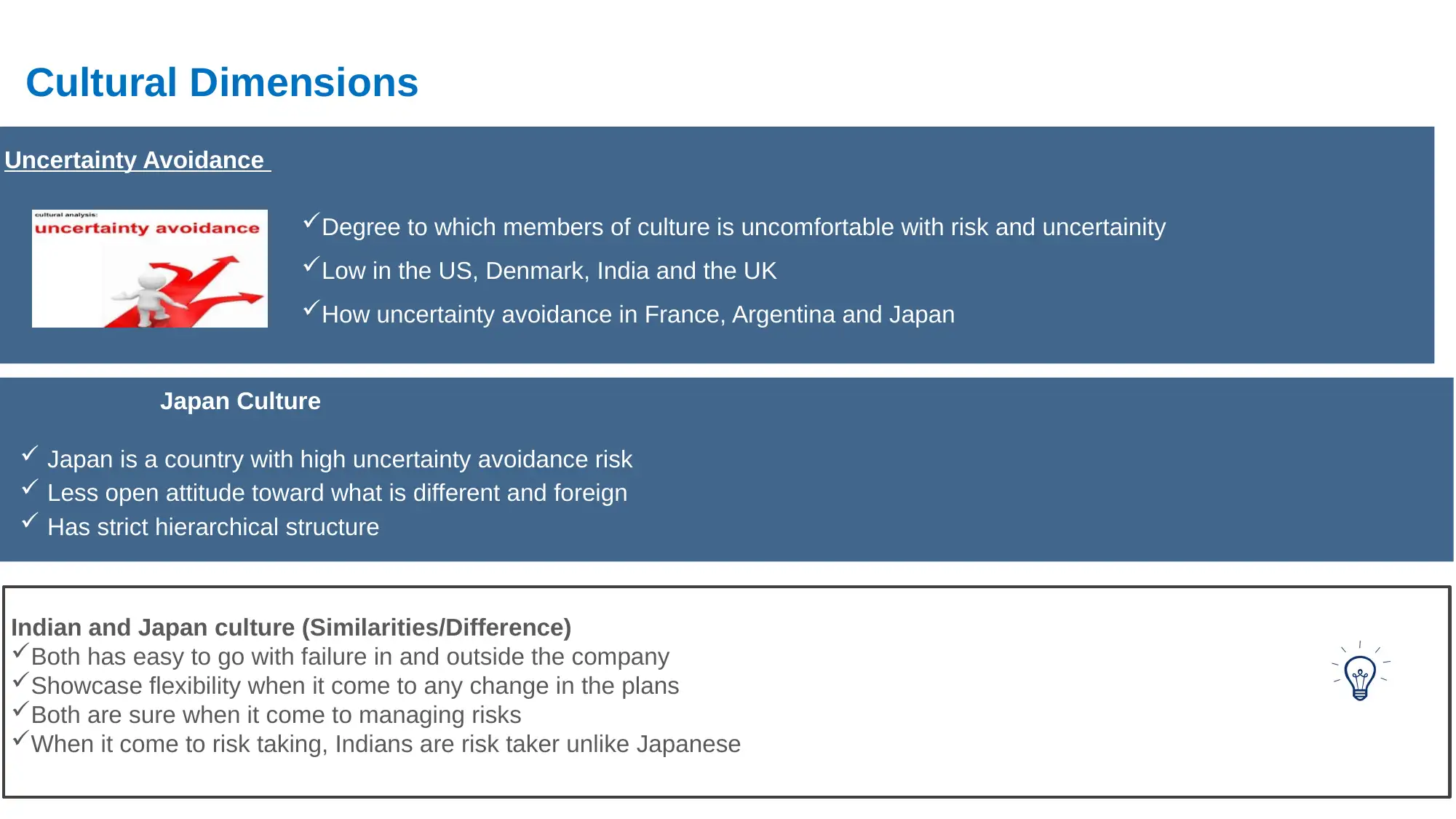
Cultural Dimensions
Degree to which members of culture is uncomfortable with risk and uncertainity
Low in the US, Denmark, India and the UK
How uncertainty avoidance in France, Argentina and Japan
Japan Culture
Japan is a country with high uncertainty avoidance risk
Less open attitude toward what is different and foreign
Has strict hierarchical structure
Indian and Japan culture (Similarities/Difference)
Both has easy to go with failure in and outside the company
Showcase flexibility when it come to any change in the plans
Both are sure when it come to managing risks
When it come to risk taking, Indians are risk taker unlike Japanese
Uncertainty Avoidance
Degree to which members of culture is uncomfortable with risk and uncertainity
Low in the US, Denmark, India and the UK
How uncertainty avoidance in France, Argentina and Japan
Japan Culture
Japan is a country with high uncertainty avoidance risk
Less open attitude toward what is different and foreign
Has strict hierarchical structure
Indian and Japan culture (Similarities/Difference)
Both has easy to go with failure in and outside the company
Showcase flexibility when it come to any change in the plans
Both are sure when it come to managing risks
When it come to risk taking, Indians are risk taker unlike Japanese
Uncertainty Avoidance
⊘ This is a preview!⊘
Do you want full access?
Subscribe today to unlock all pages.

Trusted by 1+ million students worldwide
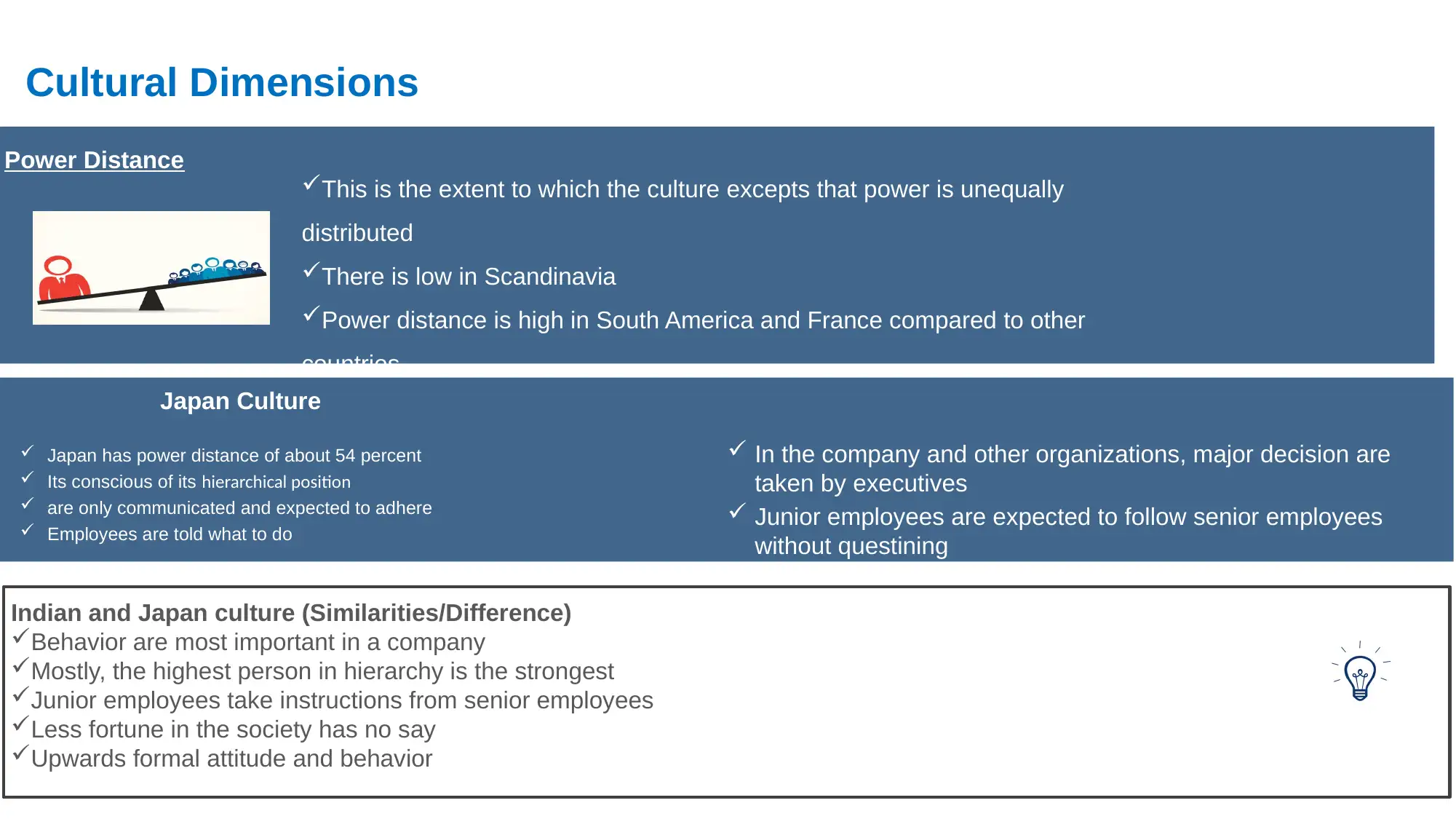
Cultural Dimensions
This is the extent to which the culture excepts that power is unequally
distributed
There is low in Scandinavia
Power distance is high in South America and France compared to other
countries.
Japan Culture
Japan has power distance of about 54 percent
Its conscious of its hierarchical position
are only communicated and expected to adhere
Employees are told what to do
Indian and Japan culture (Similarities/Difference)
Behavior are most important in a company
Mostly, the highest person in hierarchy is the strongest
Junior employees take instructions from senior employees
Less fortune in the society has no say
Upwards formal attitude and behavior
Power Distance
In the company and other organizations, major decision are
taken by executives
Junior employees are expected to follow senior employees
without questining
This is the extent to which the culture excepts that power is unequally
distributed
There is low in Scandinavia
Power distance is high in South America and France compared to other
countries.
Japan Culture
Japan has power distance of about 54 percent
Its conscious of its hierarchical position
are only communicated and expected to adhere
Employees are told what to do
Indian and Japan culture (Similarities/Difference)
Behavior are most important in a company
Mostly, the highest person in hierarchy is the strongest
Junior employees take instructions from senior employees
Less fortune in the society has no say
Upwards formal attitude and behavior
Power Distance
In the company and other organizations, major decision are
taken by executives
Junior employees are expected to follow senior employees
without questining
Paraphrase This Document
Need a fresh take? Get an instant paraphrase of this document with our AI Paraphraser
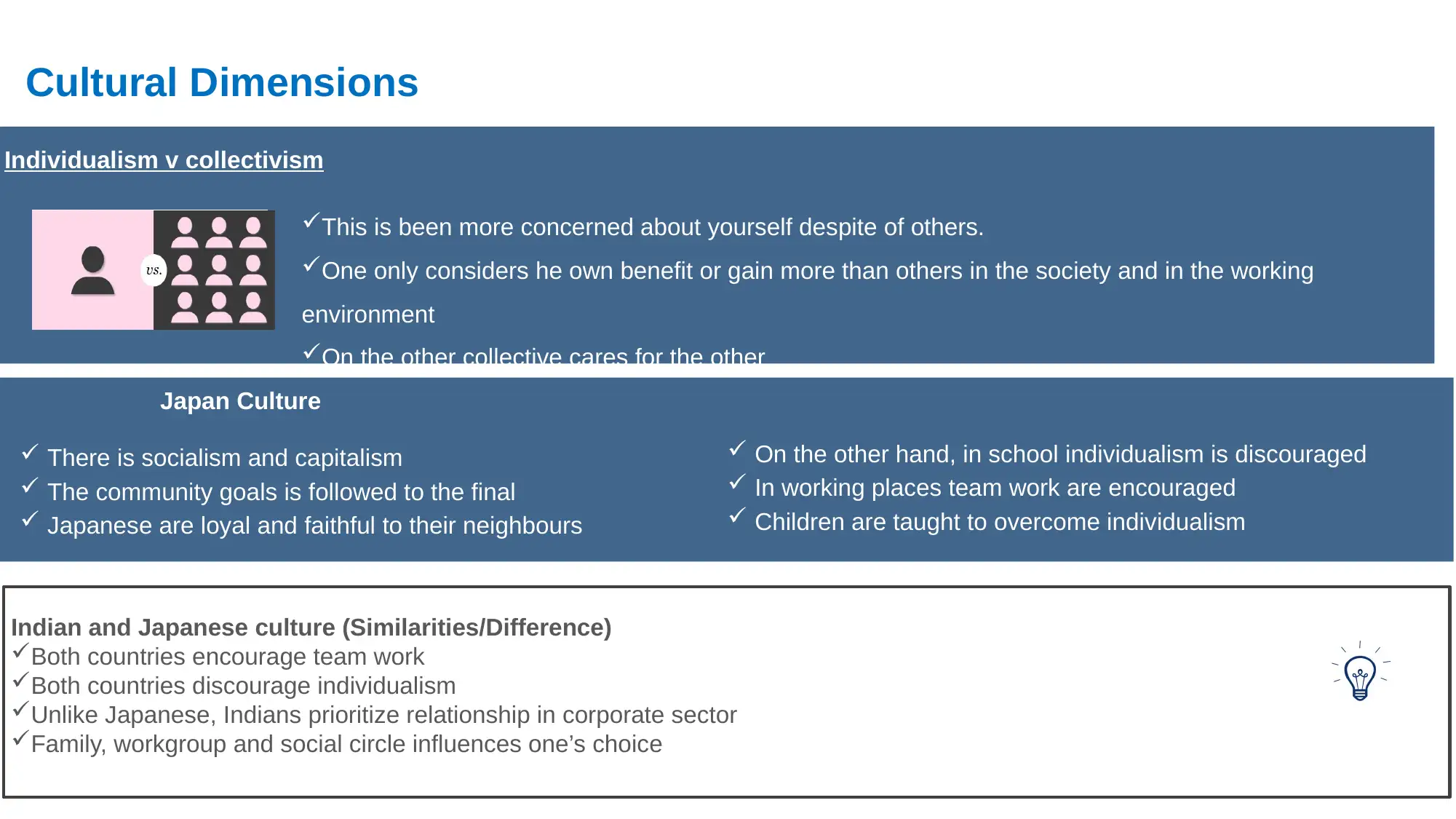
Cultural Dimensions
This is been more concerned about yourself despite of others.
One only considers he own benefit or gain more than others in the society and in the working
environment
On the other collective cares for the other
Japan Culture
There is socialism and capitalism
The community goals is followed to the final
Japanese are loyal and faithful to their neighbours
Indian and Japanese culture (Similarities/Difference)
Both countries encourage team work
Both countries discourage individualism
Unlike Japanese, Indians prioritize relationship in corporate sector
Family, workgroup and social circle influences one’s choice
Individualism v collectivism
On the other hand, in school individualism is discouraged
In working places team work are encouraged
Children are taught to overcome individualism
This is been more concerned about yourself despite of others.
One only considers he own benefit or gain more than others in the society and in the working
environment
On the other collective cares for the other
Japan Culture
There is socialism and capitalism
The community goals is followed to the final
Japanese are loyal and faithful to their neighbours
Indian and Japanese culture (Similarities/Difference)
Both countries encourage team work
Both countries discourage individualism
Unlike Japanese, Indians prioritize relationship in corporate sector
Family, workgroup and social circle influences one’s choice
Individualism v collectivism
On the other hand, in school individualism is discouraged
In working places team work are encouraged
Children are taught to overcome individualism
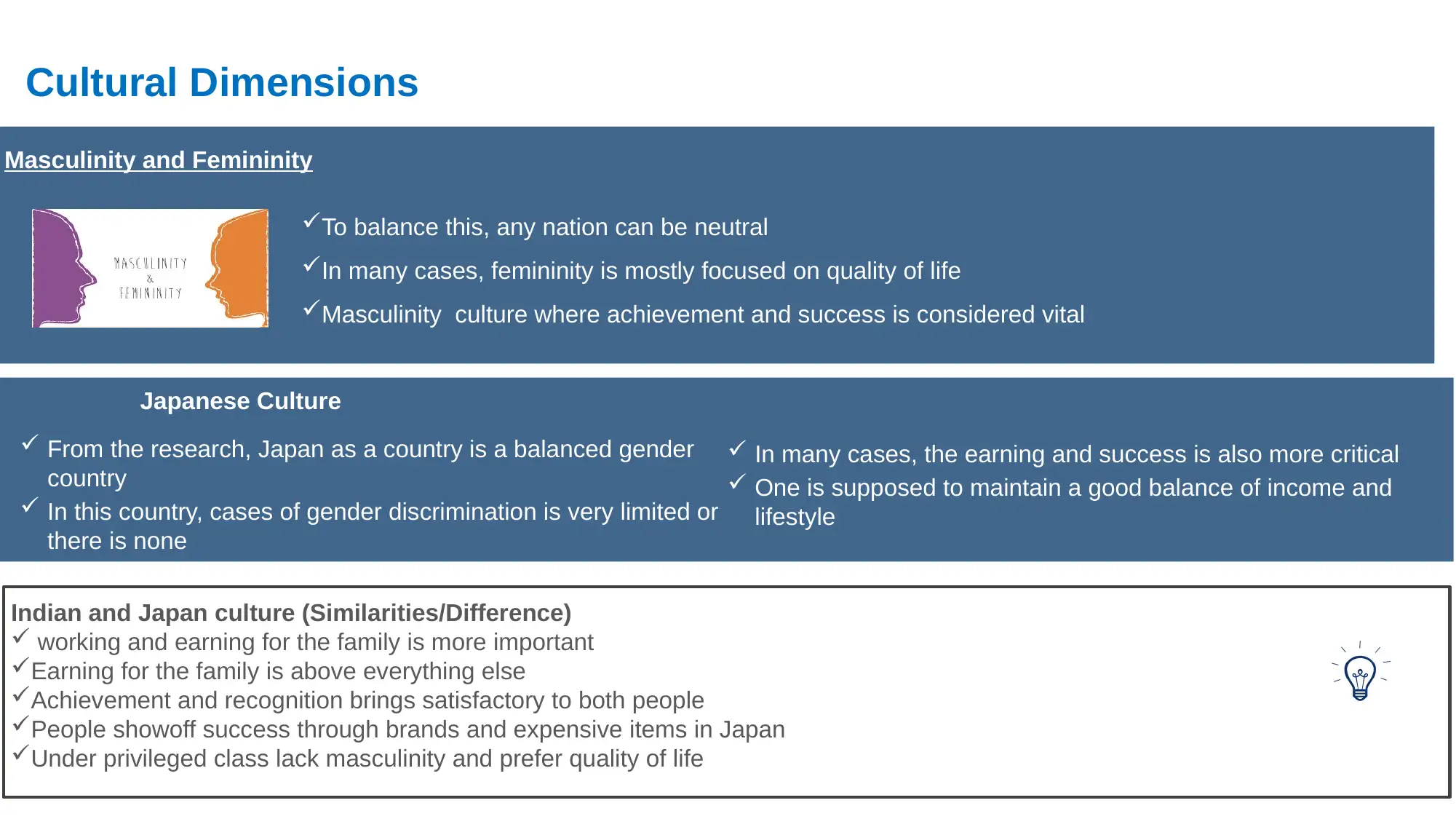
Cultural Dimensions
To balance this, any nation can be neutral
In many cases, femininity is mostly focused on quality of life
Masculinity culture where achievement and success is considered vital
Japanese Culture
From the research, Japan as a country is a balanced gender
country
In this country, cases of gender discrimination is very limited or
there is none
Indian and Japan culture (Similarities/Difference)
working and earning for the family is more important
Earning for the family is above everything else
Achievement and recognition brings satisfactory to both people
People showoff success through brands and expensive items in Japan
Under privileged class lack masculinity and prefer quality of life
Masculinity and Femininity
In many cases, the earning and success is also more critical
One is supposed to maintain a good balance of income and
lifestyle
To balance this, any nation can be neutral
In many cases, femininity is mostly focused on quality of life
Masculinity culture where achievement and success is considered vital
Japanese Culture
From the research, Japan as a country is a balanced gender
country
In this country, cases of gender discrimination is very limited or
there is none
Indian and Japan culture (Similarities/Difference)
working and earning for the family is more important
Earning for the family is above everything else
Achievement and recognition brings satisfactory to both people
People showoff success through brands and expensive items in Japan
Under privileged class lack masculinity and prefer quality of life
Masculinity and Femininity
In many cases, the earning and success is also more critical
One is supposed to maintain a good balance of income and
lifestyle
⊘ This is a preview!⊘
Do you want full access?
Subscribe today to unlock all pages.

Trusted by 1+ million students worldwide
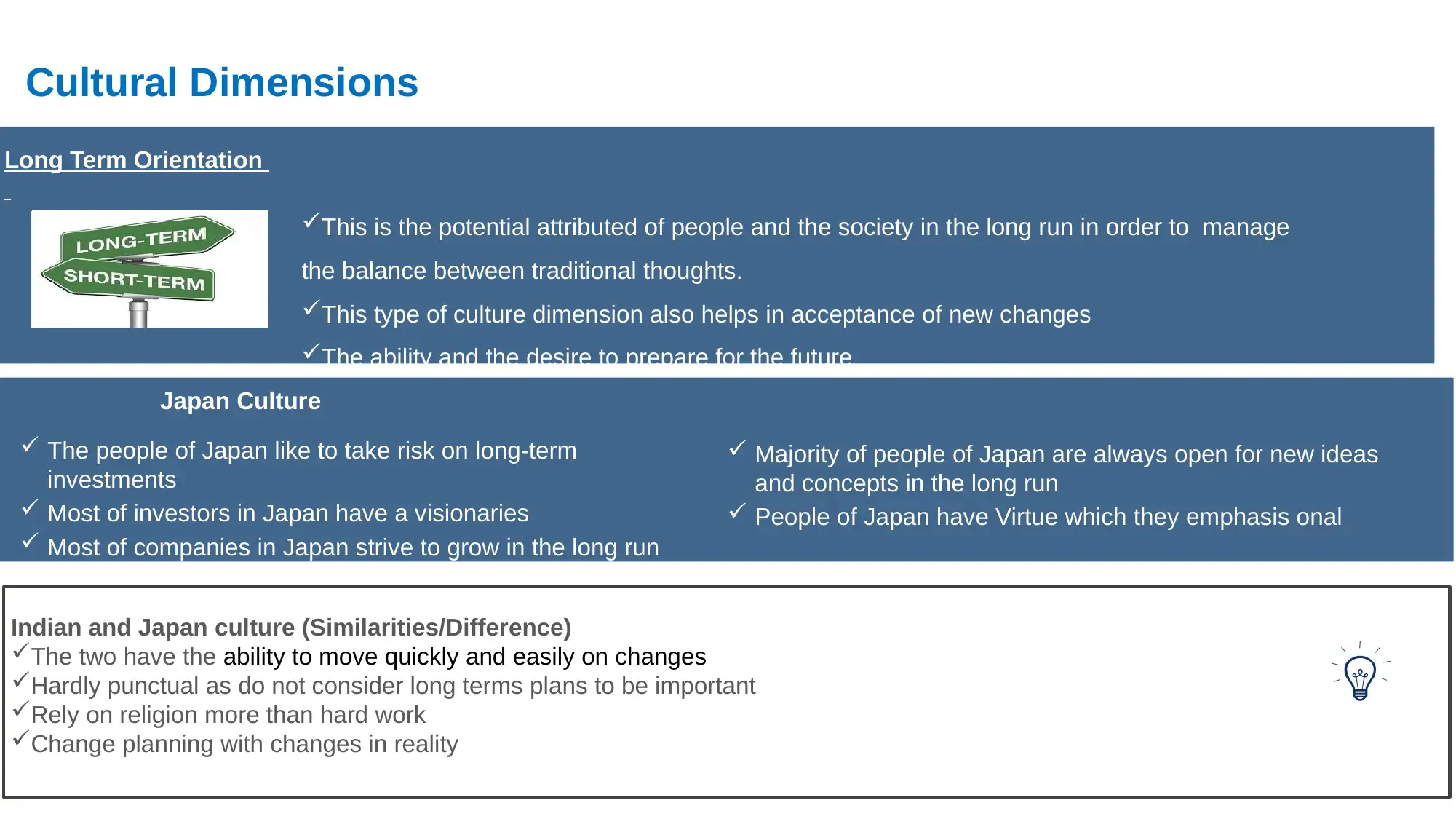
Cultural Dimensions
This is the potential attributed of people and the society in the long run in order to manage
the balance between traditional thoughts.
This type of culture dimension also helps in acceptance of new changes
The ability and the desire to prepare for the future
Japan Culture
The people of Japan like to take risk on long-term
investments
Most of investors in Japan have a visionaries
Most of companies in Japan strive to grow in the long run
Indian and Japan culture (Similarities/Difference)
The two have the ability to move quickly and easily on changes
Hardly punctual as do not consider long terms plans to be important
Rely on religion more than hard work
Change planning with changes in reality
Long Term Orientation
Majority of people of Japan are always open for new ideas
and concepts in the long run
People of Japan have Virtue which they emphasis onal
This is the potential attributed of people and the society in the long run in order to manage
the balance between traditional thoughts.
This type of culture dimension also helps in acceptance of new changes
The ability and the desire to prepare for the future
Japan Culture
The people of Japan like to take risk on long-term
investments
Most of investors in Japan have a visionaries
Most of companies in Japan strive to grow in the long run
Indian and Japan culture (Similarities/Difference)
The two have the ability to move quickly and easily on changes
Hardly punctual as do not consider long terms plans to be important
Rely on religion more than hard work
Change planning with changes in reality
Long Term Orientation
Majority of people of Japan are always open for new ideas
and concepts in the long run
People of Japan have Virtue which they emphasis onal
Paraphrase This Document
Need a fresh take? Get an instant paraphrase of this document with our AI Paraphraser
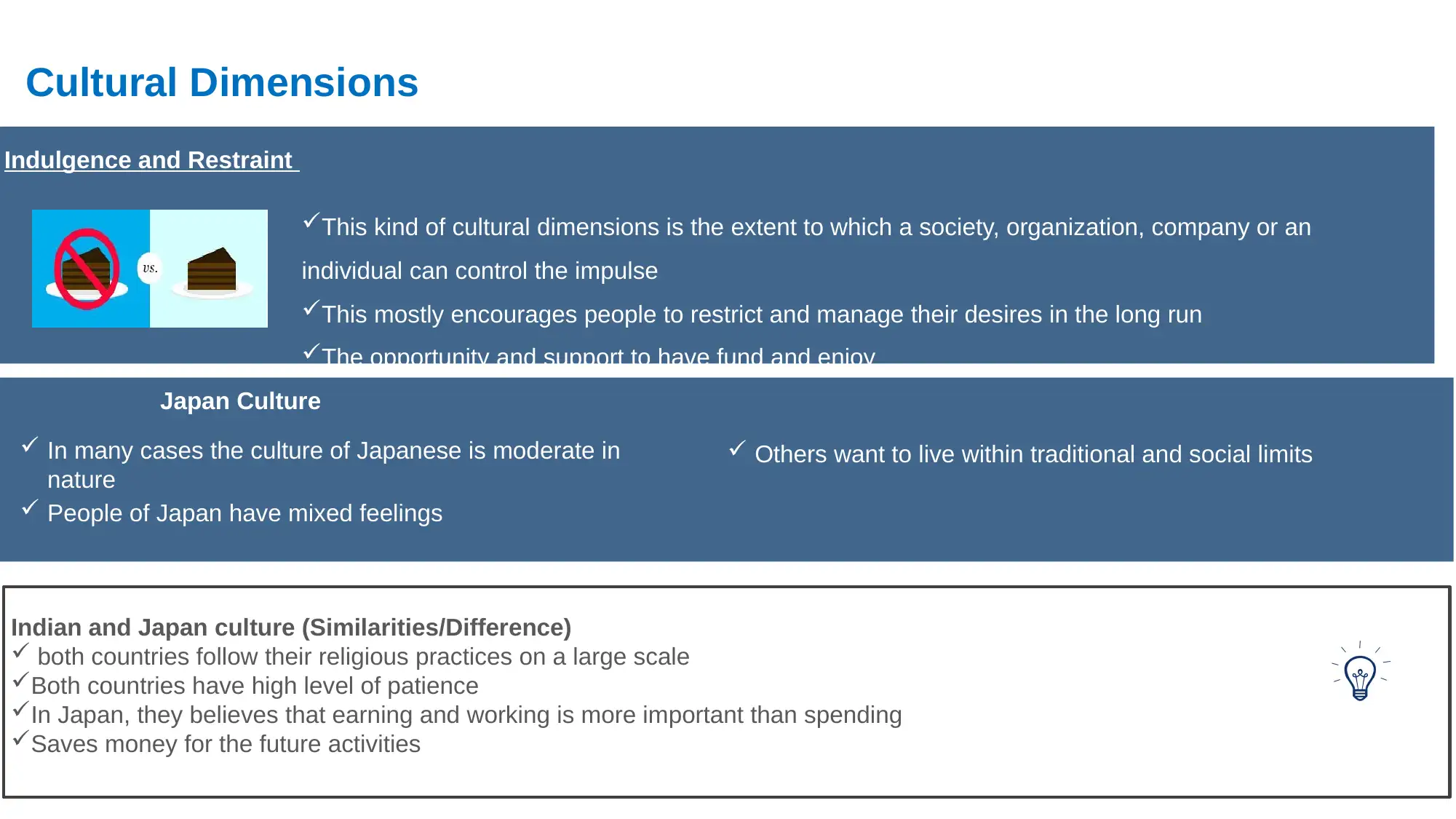
Cultural Dimensions
This kind of cultural dimensions is the extent to which a society, organization, company or an
individual can control the impulse
This mostly encourages people to restrict and manage their desires in the long run
The opportunity and support to have fund and enjoy
Japan Culture
In many cases the culture of Japanese is moderate in
nature
People of Japan have mixed feelings
Indian and Japan culture (Similarities/Difference)
both countries follow their religious practices on a large scale
Both countries have high level of patience
In Japan, they believes that earning and working is more important than spending
Saves money for the future activities
Indulgence and Restraint
Others want to live within traditional and social limits
This kind of cultural dimensions is the extent to which a society, organization, company or an
individual can control the impulse
This mostly encourages people to restrict and manage their desires in the long run
The opportunity and support to have fund and enjoy
Japan Culture
In many cases the culture of Japanese is moderate in
nature
People of Japan have mixed feelings
Indian and Japan culture (Similarities/Difference)
both countries follow their religious practices on a large scale
Both countries have high level of patience
In Japan, they believes that earning and working is more important than spending
Saves money for the future activities
Indulgence and Restraint
Others want to live within traditional and social limits
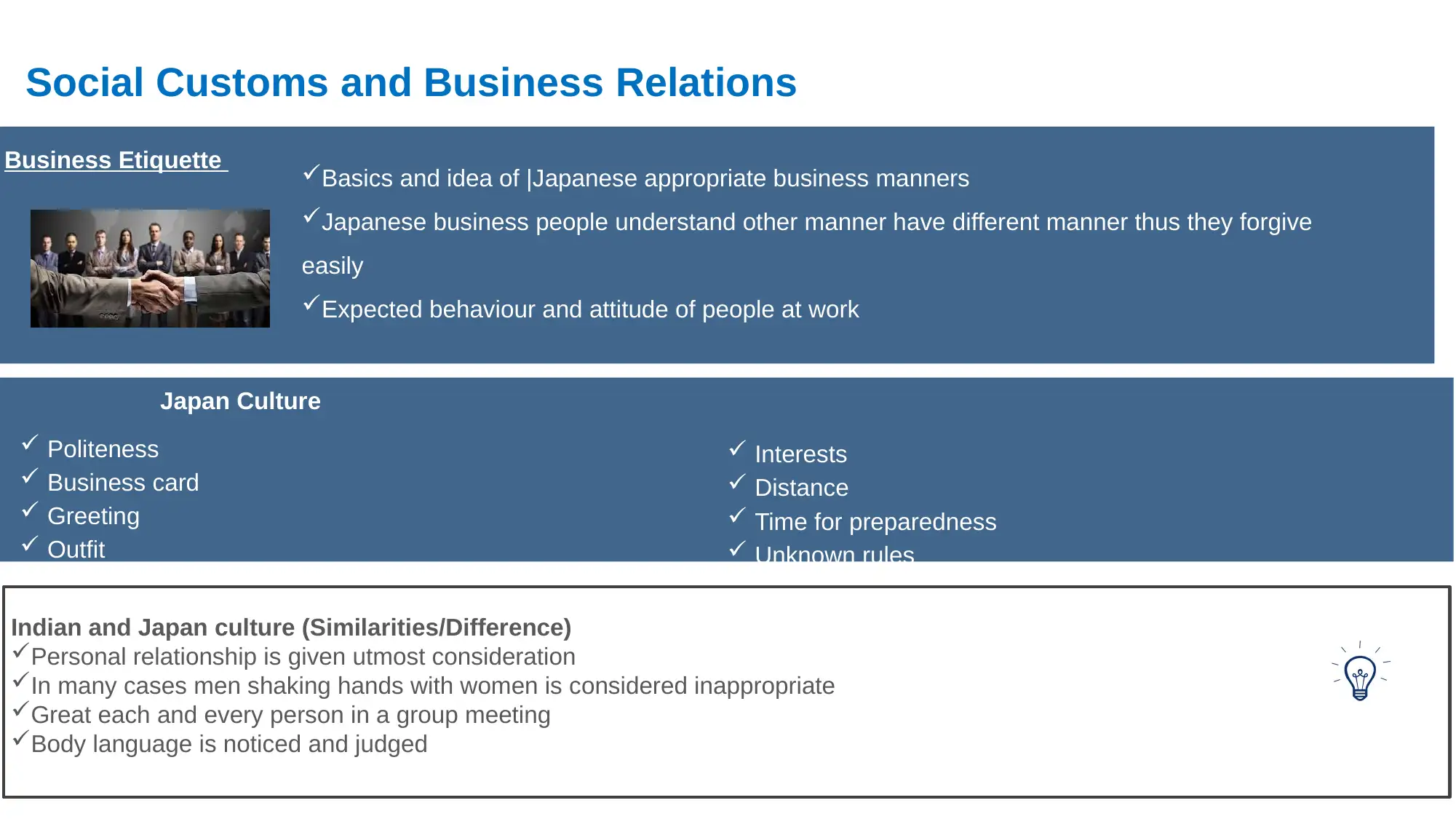
Social Customs and Business Relations
Basics and idea of |Japanese appropriate business manners
Japanese business people understand other manner have different manner thus they forgive
easily
Expected behaviour and attitude of people at work
Japan Culture
Politeness
Business card
Greeting
Outfit
Indian and Japan culture (Similarities/Difference)
Personal relationship is given utmost consideration
In many cases men shaking hands with women is considered inappropriate
Great each and every person in a group meeting
Body language is noticed and judged
Business Etiquette
Interests
Distance
Time for preparedness
Unknown rules
Basics and idea of |Japanese appropriate business manners
Japanese business people understand other manner have different manner thus they forgive
easily
Expected behaviour and attitude of people at work
Japan Culture
Politeness
Business card
Greeting
Outfit
Indian and Japan culture (Similarities/Difference)
Personal relationship is given utmost consideration
In many cases men shaking hands with women is considered inappropriate
Great each and every person in a group meeting
Body language is noticed and judged
Business Etiquette
Interests
Distance
Time for preparedness
Unknown rules
⊘ This is a preview!⊘
Do you want full access?
Subscribe today to unlock all pages.

Trusted by 1+ million students worldwide
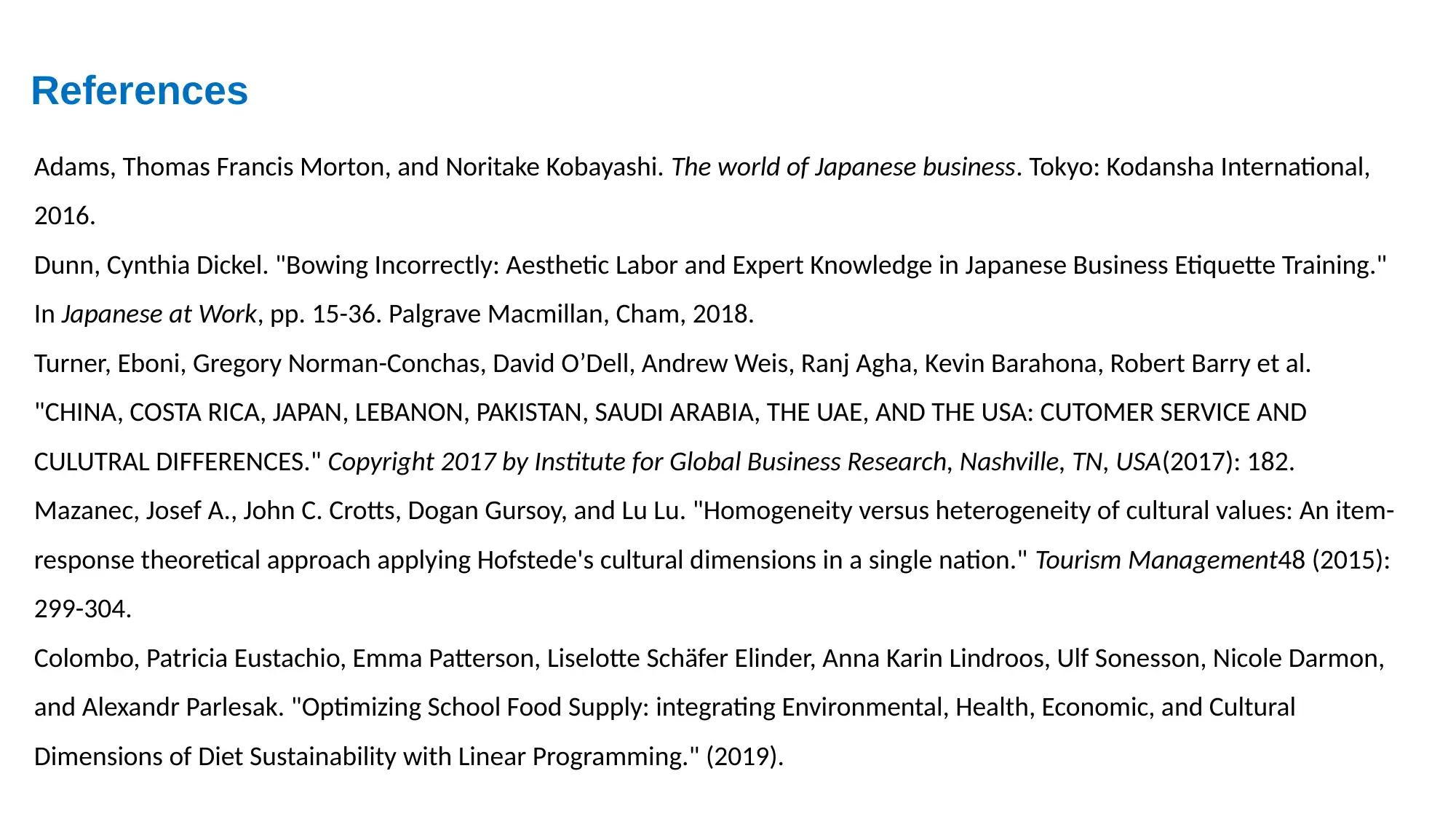
References
Adams, Thomas Francis Morton, and Noritake Kobayashi. The world of Japanese business. Tokyo: Kodansha International,
2016.
Dunn, Cynthia Dickel. "Bowing Incorrectly: Aesthetic Labor and Expert Knowledge in Japanese Business Etiquette Training."
In Japanese at Work, pp. 15-36. Palgrave Macmillan, Cham, 2018.
Turner, Eboni, Gregory Norman-Conchas, David O’Dell, Andrew Weis, Ranj Agha, Kevin Barahona, Robert Barry et al.
"CHINA, COSTA RICA, JAPAN, LEBANON, PAKISTAN, SAUDI ARABIA, THE UAE, AND THE USA: CUTOMER SERVICE AND
CULUTRAL DIFFERENCES." Copyright 2017 by Institute for Global Business Research, Nashville, TN, USA(2017): 182.
Mazanec, Josef A., John C. Crotts, Dogan Gursoy, and Lu Lu. "Homogeneity versus heterogeneity of cultural values: An item-
response theoretical approach applying Hofstede's cultural dimensions in a single nation." Tourism Management48 (2015):
299-304.
Colombo, Patricia Eustachio, Emma Patterson, Liselotte Schäfer Elinder, Anna Karin Lindroos, Ulf Sonesson, Nicole Darmon,
and Alexandr Parlesak. "Optimizing School Food Supply: integrating Environmental, Health, Economic, and Cultural
Dimensions of Diet Sustainability with Linear Programming." (2019).
Adams, Thomas Francis Morton, and Noritake Kobayashi. The world of Japanese business. Tokyo: Kodansha International,
2016.
Dunn, Cynthia Dickel. "Bowing Incorrectly: Aesthetic Labor and Expert Knowledge in Japanese Business Etiquette Training."
In Japanese at Work, pp. 15-36. Palgrave Macmillan, Cham, 2018.
Turner, Eboni, Gregory Norman-Conchas, David O’Dell, Andrew Weis, Ranj Agha, Kevin Barahona, Robert Barry et al.
"CHINA, COSTA RICA, JAPAN, LEBANON, PAKISTAN, SAUDI ARABIA, THE UAE, AND THE USA: CUTOMER SERVICE AND
CULUTRAL DIFFERENCES." Copyright 2017 by Institute for Global Business Research, Nashville, TN, USA(2017): 182.
Mazanec, Josef A., John C. Crotts, Dogan Gursoy, and Lu Lu. "Homogeneity versus heterogeneity of cultural values: An item-
response theoretical approach applying Hofstede's cultural dimensions in a single nation." Tourism Management48 (2015):
299-304.
Colombo, Patricia Eustachio, Emma Patterson, Liselotte Schäfer Elinder, Anna Karin Lindroos, Ulf Sonesson, Nicole Darmon,
and Alexandr Parlesak. "Optimizing School Food Supply: integrating Environmental, Health, Economic, and Cultural
Dimensions of Diet Sustainability with Linear Programming." (2019).
1 out of 10
Related Documents
Your All-in-One AI-Powered Toolkit for Academic Success.
+13062052269
info@desklib.com
Available 24*7 on WhatsApp / Email
![[object Object]](/_next/static/media/star-bottom.7253800d.svg)
Unlock your academic potential
Copyright © 2020–2025 A2Z Services. All Rights Reserved. Developed and managed by ZUCOL.




